The Grande Arche de la Défense is a modern triumphal arch built at the end of the twentieth century in La Défense, Paris’s modern business district. The arch marks the end of the Triumphal Way, the east-west axis that connects the Louvre with La Défense.
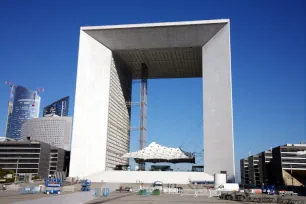
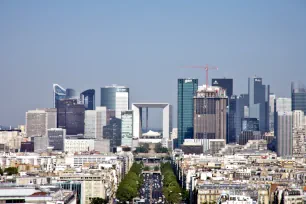
In the early 1980s, then president François Mitterrand commissioned the construction of the Grands Projects (Great Projects) to celebrate the 200th anniversary of the French Revolution in 1989. The projects aimed to revitalize the city and promote culture. Some of the most famous of these urban projects include the construction of the Louvre Pyramid, the Bastille Opera, the Bibliothèque Nationale and the Arche de la Défense.
La Défense
The latter had been initiated by Mitterrand’s predecessor, Giscard d’Estaing. At the time, La Défense, the futuristic business district of Paris, was often devoid of life, especially during weekends, and the desolate concrete landscape was in need of an iconic centerpiece that would attract visitors and act as an urban center and create an identity for the new district.
In 1982, Mitterrand launched an international competition to create such a centerpiece for La Défense. The competition attracted 424 entries, and in 1983 a scheme by Danish architect Johann Otto von Spreckelsen was chosen as the winner.
Triumphal Way
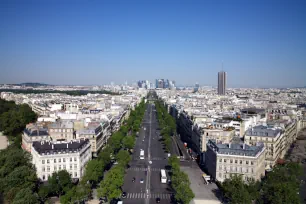
Von Spreckelsen designed an enormous arch that looks like a giant hollow cube. Construction started in 1984 and the arch was completed in 1989, just in time for the bicentennial celebration of the French Revolution.
The arch is set at the end of the ‘parvis’, the central pedestrianized plateau that forms La Défense‘s main boulevard. It marks the end of the Voie Triumphale (Triumphal Way) or Grand Ax (Great Axis), the historical east-west axis that runs from the Louvre along the Champs-Élysées to La Défense.
The choice of an arch was no coincidence; the Grande Arche de la Défense is the third arch on the Triumphal way, and it nicely complements the two historic arches on this axis: the Arc du Carrousel near the Louvre and the famous Arc de Triomphe. While these arches were built to celebrate military victories, the new arch emphasizes the importance of La Défence as France’s financial and business center. Fittingly, the modern arch contains thirty-five floors of office space.
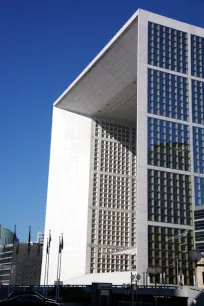
The Arch
The arch is gigantic: it is twice the size of the Arc de Triomphe, and its archway is large enough to fit the Notre-Dame Cathedral. The concrete structure rises to a height of 110 meters (361 feet) and it has a width of 106 meters (348 feet). The sides are 19 meters wide and contain offices and conference rooms.
The arch is set at a six-degree angle towards the axis of the Triumphal Way. This was not originally planned, but it was necessary to ensure that the piles that support the monumental arch could avoid the tunnels underneath. The exterior of the 300,000 ton weighing structure is clad in white Carrara marble, granite and glass.
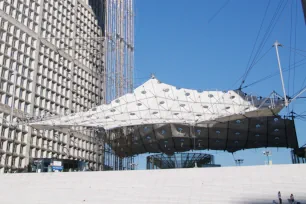
Spanned between the inside of the archway is a tent-like structure dubbed the ‘cloud’. It was created to reduce wind resistance, and it also achieves the effect of seemingly reducing the gigantic proportions of the arch. The cloud is made of white plastic panels that are suspended by steel cables to the sides of the arch.
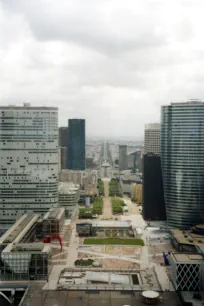
Viewing Platform
Glass elevators bring visitors through the ‘cloud’ to the top of the arch. Stairs lead to the observation platform on the roof. From here, at a height of 110 meters, you have a unique perspective over Paris. Weather permitting, you could see the whole length of the Triumphal Way, all the way towards the Louvre.
In 2009, after a problem occurred with one of the glass elevators, the rooftop closed to the public. It only reopened eight years later, on June 1, 2017. Now, in addition to the glass elevators, two express elevators inside the south wall of the arch are open to visitors in case that the glass elevators are shut down due to strong winds.

